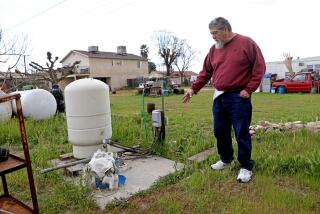PORT HUENEME : 2 Wells to Be Sunk to Test for Seawater
- Share via
The United Water Conservation District will drill two additional monitoring wells in the Oxnard Plain to determine the extent to which ground-water quality around Port Hueneme may be threatened by the intrusion of seawater.
The decision to drill the new wells follows the discovery of seawater in a monitoring well on the Port Hueneme waterfront last year, U.S. Geological Survey Hydrologist Peter Martin said.
One of the two new wells will be drilled half a mile from the contaminated Hueneme well. The second well will be drilled five miles to the east. “We are trying to define the inland extent of seawater intrusion,” Martin said.
Seawater intrusion is a slow process in which an area’s underground reservoirs, called aquifers, are slowly contaminated with ocean water. The intrusion eventually makes the water undrinkable if the process is not arrested. The intrusion is caused by pumping more water from the aquifers than is replaced by rainfall.
Martin called the intrusion in the Port Hueneme monitoring well “very serious. The drinking-water standard is 250 milligrams per liter for chloride, and we have 7,000 milligrams per liter” in the monitoring well.
The U.S. Geological Survey, which will operate the new wells as part of a study of seawater intrusion in the region, had requested $300,000 from United to add five new wells to the 18 already in the district. The district’s board of directors approved $100,000 for placement of just two wells.
Frederick J. Gientke, United’s general manager, said more exploratory wells could be funded for the study later.
“If the information from the (new wells) is not adequate, then we will meet with them and talk about additional wells,” Gientke said. “Our hope is that there is not seawater intrusion” in the new wells.
Preliminary results from the two new wells are expected in about six months.
More to Read
Sign up for Essential California
The most important California stories and recommendations in your inbox every morning.
You may occasionally receive promotional content from the Los Angeles Times.













